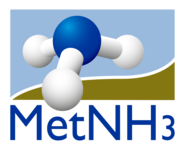About MetNH3
MetNH3 stands for metrology for ammonia in ambient air and is a Joint Research Project (JRP) ENV55 running for three years starting 1st of June 2014 under the European Metrology Research Project (EMRP).
The measurement of ammonia in air is a sensitive and priority issue due to its harmful effects on human health and ecosystems. The European Directive 2001/81/EC on "National Emission Ceilings for Certain Atmospheric Pollutants (NEC)" regulates ammonia emissions in the member states. However, there is a lack of regulation regarding the analytical techniques to use, the maximum allowed uncertainty, the quality assurance and quality control (QC/QA) procedures and the metrological traceability infrastructure to underpin ammonia measurements.
The discrepancies among European NMIs are substantial for the analysis of certified reference material (CRM) in spite of them having been analysed at 30 to 50 µmol/mol and thus at amount of substance fractions far above those of ambient air. Moreover, the performance of the multitude of applied measurement techniques varies in both resolution as well as precision. This threatens not only the credibility of instrumental performance due to insufficient means provided for calibration, but also the scientific value of extensive ambient air monitoring by national networks as well as the comparability of data across countries.
The JRP aims at achieving metrological traceability for ammonia measurements in air from primary certified reference material and instrumental standards to the field level. It consists of three technical work packages (WPs):
WP 1 aims at developing improved reference gas mixtures by static and dynamic gravimetric generation methods. Traceable preparative calibration standards of ammonia amount fractions similar to those in ambient air based on existing methods for other reactive analytes will be realised and characterised. This requires the availability of high purity matrix gas with validated ammonia amount fractions as well as the identification and quantification of adsorption/desorption and humidity effects occurring in analytical systems. Results of WP1
WP 2 aims at developing and characterising laser based optical spectrometric standards. The applicability of open-path and extractive measurement techniques as optical transfer standards will be evaluated and characterised according to metrological standards. A transportable optical transfer standard, i.e. a spectrometer suitable for traceable measurement of ambient ammonia amount fractions of ambient air (0.5 to 500 nmol/mol) will be developed. This offers an alternative to the application of gas standards for the calibration and validation of instruments. Results of WP2
WP 3 aims at establishing the transfer from high-accuracy standards to field applicable methods Characterised exposure chambers as well as field sites will be employed for validation and comparison experiments to test and evaluate the Performance of different instruments and measurement methods at ammonia amount of substance fractions of the ambient air. As a result, guidance for the proper use of certified reference materials and sampling methods for field measurements will be provided. Results of WP3
An overview or the project is given in the final publishable summary.

